Unveiling Uzbekistan - a journey through time
The double-landlocked Central Asian country (one of two in the world, the other being Lichtenstein) boasts a rich history and culture deeply intertwined with Islam. The former Soviet Republic is known for its ancient Silk Road trade route stops, such as Bukhara, Samarkand and Khiva. It became a melting pot of civilisations due to its position along the route, which also served as a highway for the spread of Islam.
Traditionally, it was difficult to travel in this Central Asian state. But the country is now welcoming visitors, having put in place a number of measures over the last few years to make it easier for tourists to visit. The country's various mosques, madrasas, and mausoleums are well-preserved examples of its past. With its culture, heritage, and natural beauty, it's easy to see why Uzbekistan is a sought-after designation for travellers - there's just so much to see and do in the country!
Early Islamic Influences
Islam gained a foothold in the region in the 8th century, marking a turning point in the cultural and religious landscape of the land. One of the earliest and most notable centres of Islamic learning was the city of Bukhara, where Imam Bukhari was born on 21st July 810. Imam Bukhari is a key figure in Sunni Islam and best known for compiling the “Sahih al Bukhari”, one of the most comprehensive collections of hadith and authoritative books after the Quran.
Other notable scholars from modern-day Uzbekistan include the hadith collator Imam Tirmidhi, the well-known Hanafi scholar Abu Mansur Maturidi, the Timurid ruler and astronomer Ulugh Beg, the polymaths Al-Khwarizmi and Al-Biruni as well as Ibn Sina (Avicenna), often described as the father of modern medicine. It shows how significant the region was for Islamic and world scholarship.
The Golden Age of Islamic Civilisation
The territory became a world-leading centre of science, medicine, philosophy and culture during the Golden Age of Islam. Cities like Bukhara, Samarkand, and Khiva were renowned for being centres of learning and innovation. One of the iconic landmarks in Uzbekistan is the Registan Square in Samarkand. It's adorned with three stunning madrasas, reflecting the brilliance of Islamic architecture during the golden period.
Another architectural marvel, with its intricate tile work and majestic domes, is the Bibi-Khanym Mosque, also in Samarkand. Built in the 15th century, it's still one of the largest mosques in Central Asia and can hold around 10,000 worshippers.
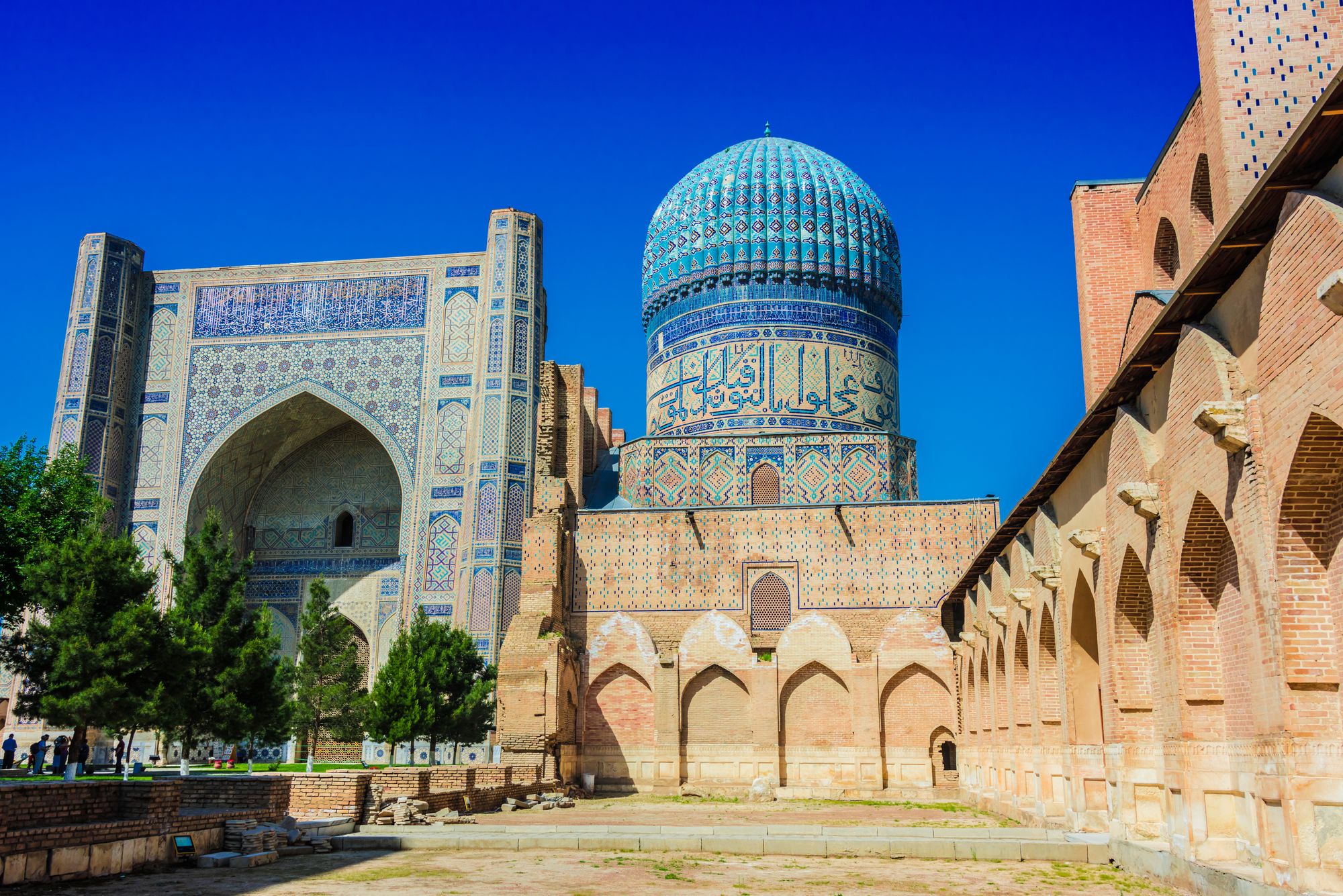
These historical sites bear witness to the region's Islamic heritage — and the reason why the country is attracting so many Muslim tourists.
The Legacy of Sufism
Uzbekistan's Muslim history is deeply intertwined with Sufism. Sufi orders played an important role in connecting the region with the spiritual realm of Islam. Born in Bukhara, Bahauddin Naqshbandi founded one of the largest Sufi Sunni orders, the Naqshbandi. Located near Bukhara, the mausoleum of Bahauddin is a key site for Sufis. Many Sufi monuments and mansions have been preserved in Uzbekistan up to the present day. Throughout its history, Uzbekistan has been a land of religious tolerance, with different sects of Islam coexisting peacefully. It's influenced and shaped the diverse expressions of Islam you can see on show in the country.
Architectural marvels
Since its independence from the Soviet Union, Uzbekistan has increasingly embraced its Islamic heritage. The government undertook initiatives to preserve and promote its religious, historical and cultural treasures.
Five sites in Uzbekistan are included in UNESCO's World Heritage List. There are four cultural sites: the Historic Centre of Bukhara, Itchan Kala, the Historic Centre of Shakhrisyabz, and Samarkand – Crossroad of Cultures. It also has one natural site on the list - Western Tien-Shan. In addition to its inscribed sites, there are over 30 other locations on the Uzbekistan UNESCO tentative list.
So no matter what type of traveller you are, Uzbekistan has something for everyone. It's a must-visit country for anyone interested in experiencing its unique blend of old and new.
Top attractions in Uzbekistan
Uzbekistan is a special place for Muslims who want to learn about history and spirituality. Visitors can explore palaces, mosques and iconic architectural wonders that showcase the country's rich past. It's worth mentioning that some Muslims believe that erecting monuments, mausoleums or tombs to honour the deceased is discouraged in Islam. Uzbekistan has many of these types of attractions. Travellers who find these practices conflict with their beliefs should take this into consideration when deciding where to visit.
Bukhara
Situated on the Silk Route, Bukhara is over 2,000 years old. It's seen as one of the best examples of a well-preserved Central Asian Islamic city from the 10th to 17th centuries. It contains nearly 140 architectural monuments from the Middle Ages and its historic centre is a UNESCO World Heritage Site.
- Poi-Kalan - a religious complex that consists of the Kalan Mosque, the Kalan Minaret, and the Mir-i Arab Madrasa. Completed in 1126, it translates as “Foot of the Great One” from the Persian referring to the famed Kalan Minaret, a 45.6 metres circular tower made from brick, which is one of the defining features of Bukhara's skyline. It has managed to weather war, natural disaster and time to still stand to this day. In times of war, warriors used the minaret as a watchtower to lookout for enemies.
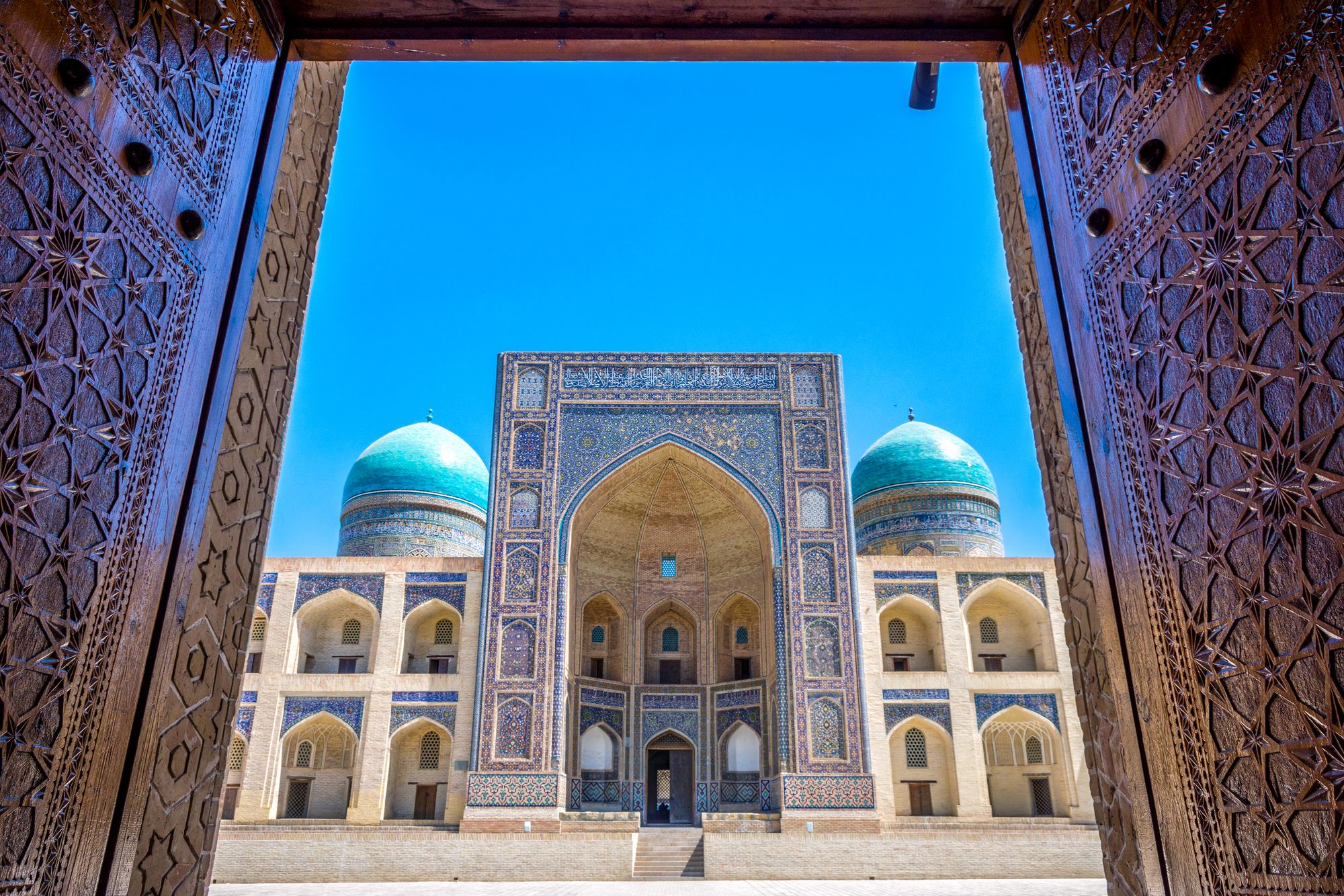
- Lyab-i Hauz - The name translates to “around the pool” and the complex was a gathering place for residents and traders. The 16th-century pool, which is flanked by two madrasas, once served as the city's primary source of water. It’s a popular tourist attraction offering a glimpse into the city's cultural heritage and traditional ways that evokes the ambience of life of old Bukhara.
- Samanid Mausoleum - It was built around 892 and is a historic architectural masterpiece and one of the most significant and well-preserved examples of early Islamic architecture in Central Asia. It's the resting place for the influential leaders that ruled the Samanid Empire, including Ismail Samani - the founder of the Samanid dynasty.
- Magoki Attori Mosque - Built in 714, it's the oldest mosque in Bukhara. The name is derived from the Persian words “magoki” meaning “inward-facing”, and “attori” meaning “spices” and reflects the mosque's history, as it was built on the site of a former Zoroastrian fire temple, and later, a spice market. The mosque is associated with the Umayyad general and governor Qutayba Ibn Muslim, one of the first people to bring Islam to Central Asia and conqueror of Bukhara.
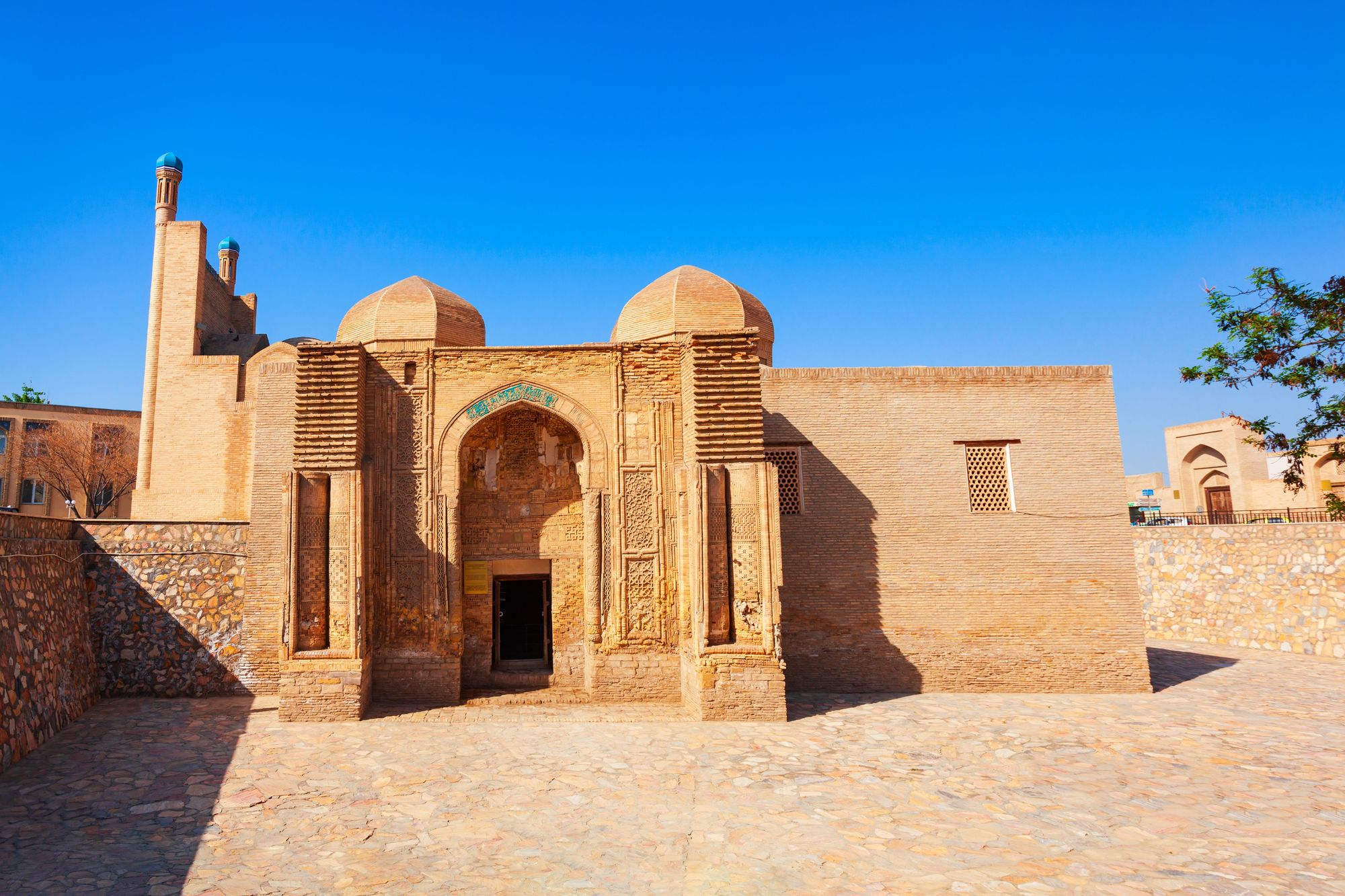
- Ark Citadel - Initially built around the 5th century it is one of the most ancient and historically significant landmarks in the city, with a history that spans over a thousand years. This massive fortress served as a residence for Bukhara's rulers. It was also home to significant figures like the philosopher and scientist Ibn Sina and Persian polymath Omar Khayyam.
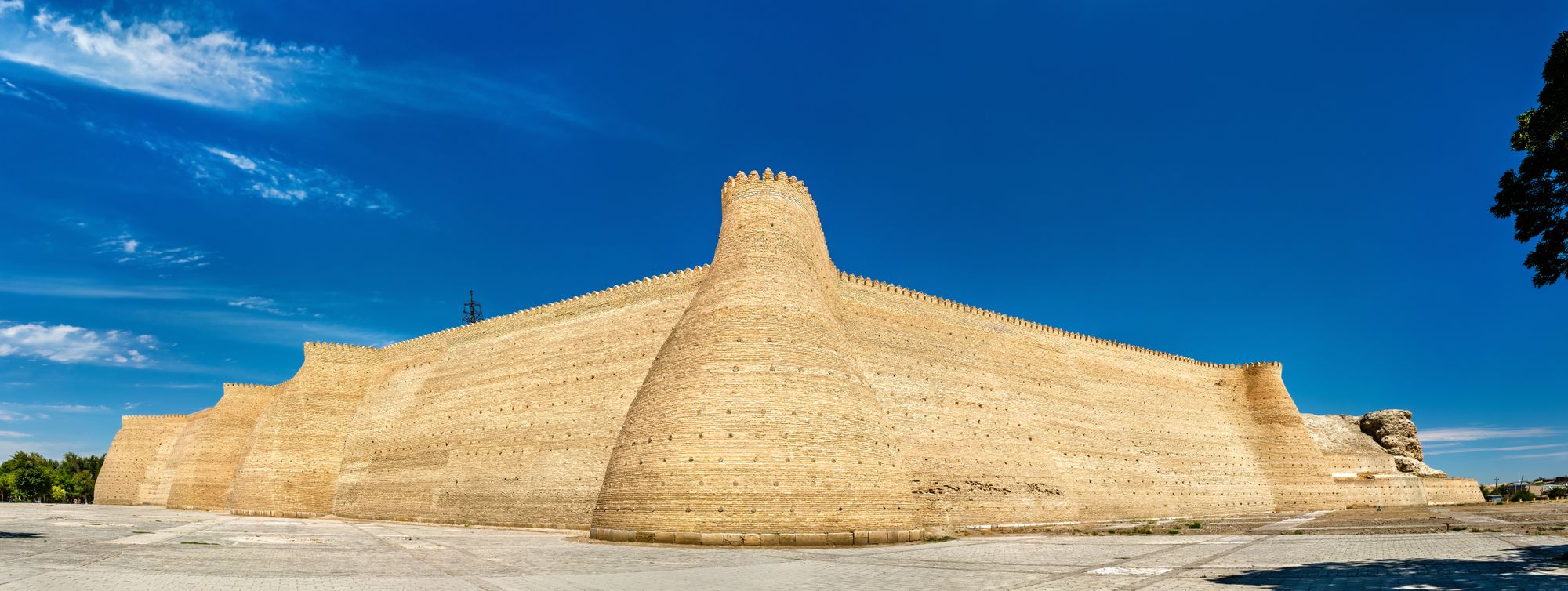
- 17th-century madrasas - Check out the many madrasas from that period, including Magoki Kurns, Abdulaziz-Khan and Nadir Divan-Beghi.
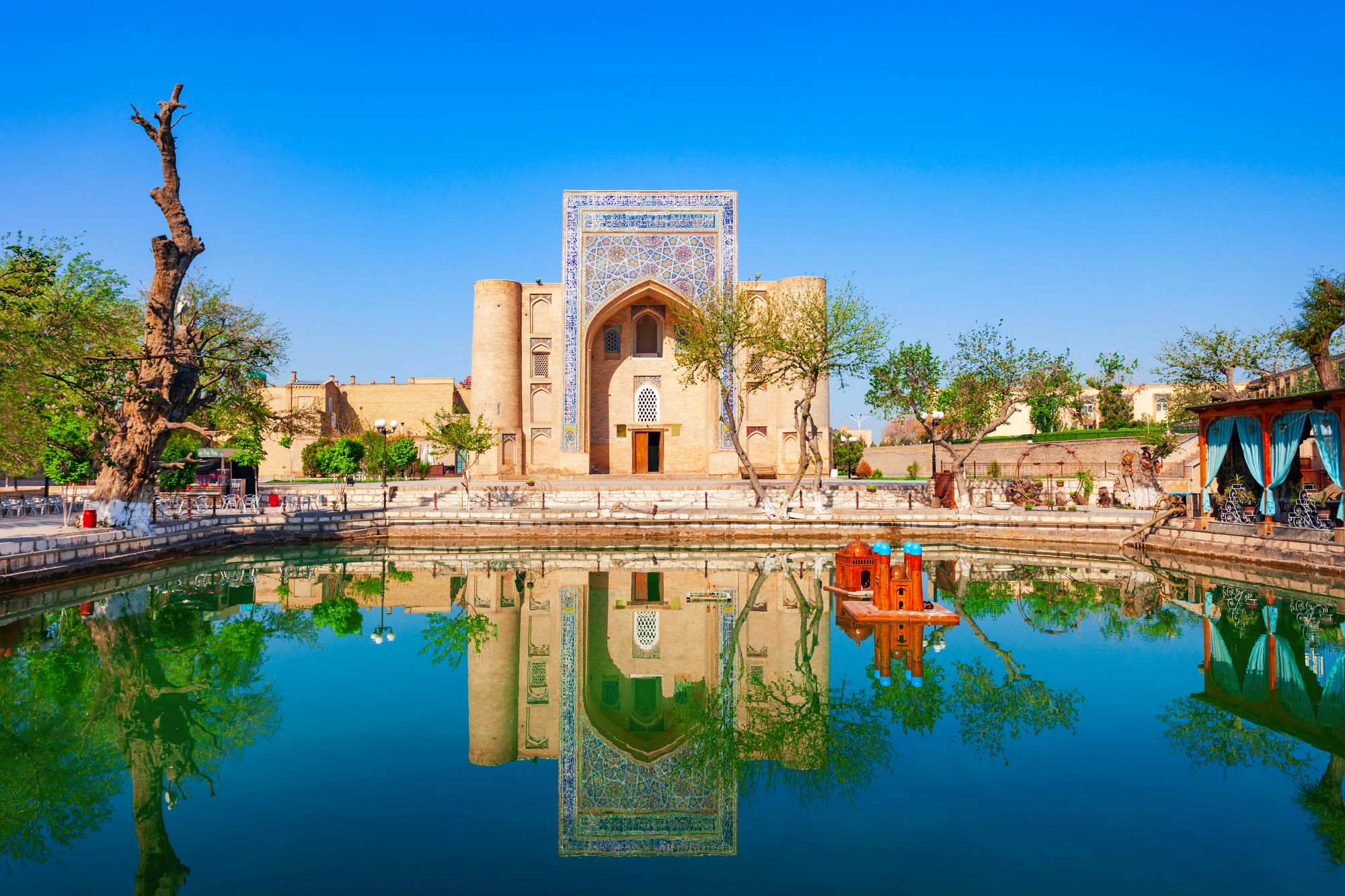
- Abu Ali Ibn Sino (Avicenna) Museum, Afshona - Named after the Persian polymath Ibn Sina, also known as Abu Ali ibn Sina, and often known in the West as “Avicenna”, who was born in 980 in Bukhara and is regarded as one of the most significant physicians, astronomers, thinkers and writers of the Islamic Golden Age, and the father of early modern medicine. Of the 450 works he is believed to have written, around 240 have survived, including 150 on philosophy and 40 on medicine. His most famous works are “The Book of Healing” (Kitab al-Shifa), a philosophical and scientific encyclopaedia, and “The Canon of Medicine” (al-Qanun fi al-Tibb), a medical encyclopaedia which became a standard medical text at many mediaeval universities and remained in use as late as 1650. The museum hosts more than 400 exhibits of material and spiritual culture associated with the epoch of Abu Ali ibn Sino and the history of Bukhara in the 9th and 10th century.
Samarkand
“The Pearl of the East”, ”The Mirror of the World”, and even “The Face of the Earth”" are just some of the names given to the place to illustrate its beauty. It's easy to see why. The city was a vital centre on the Great Silk Road, bringing diverse cultural, academic, religious, and architectural richness to the city. In 2001, UNESCO added the city to its World Heritage List as Samarkand - Crossroads of Cultures.
- Imam al-Bukhari's Mausoleum - Imam Bukhari died in the village of Khartang, 25 km from Samarkand, in 870. The place had been abandoned for centuries until a memorial complex was built in 1998, using the same ancient architectural traditions. The complex now consists of Al-Bukhari's tomb, a mosque, a madrasa, a library, and a collection of Qurans.
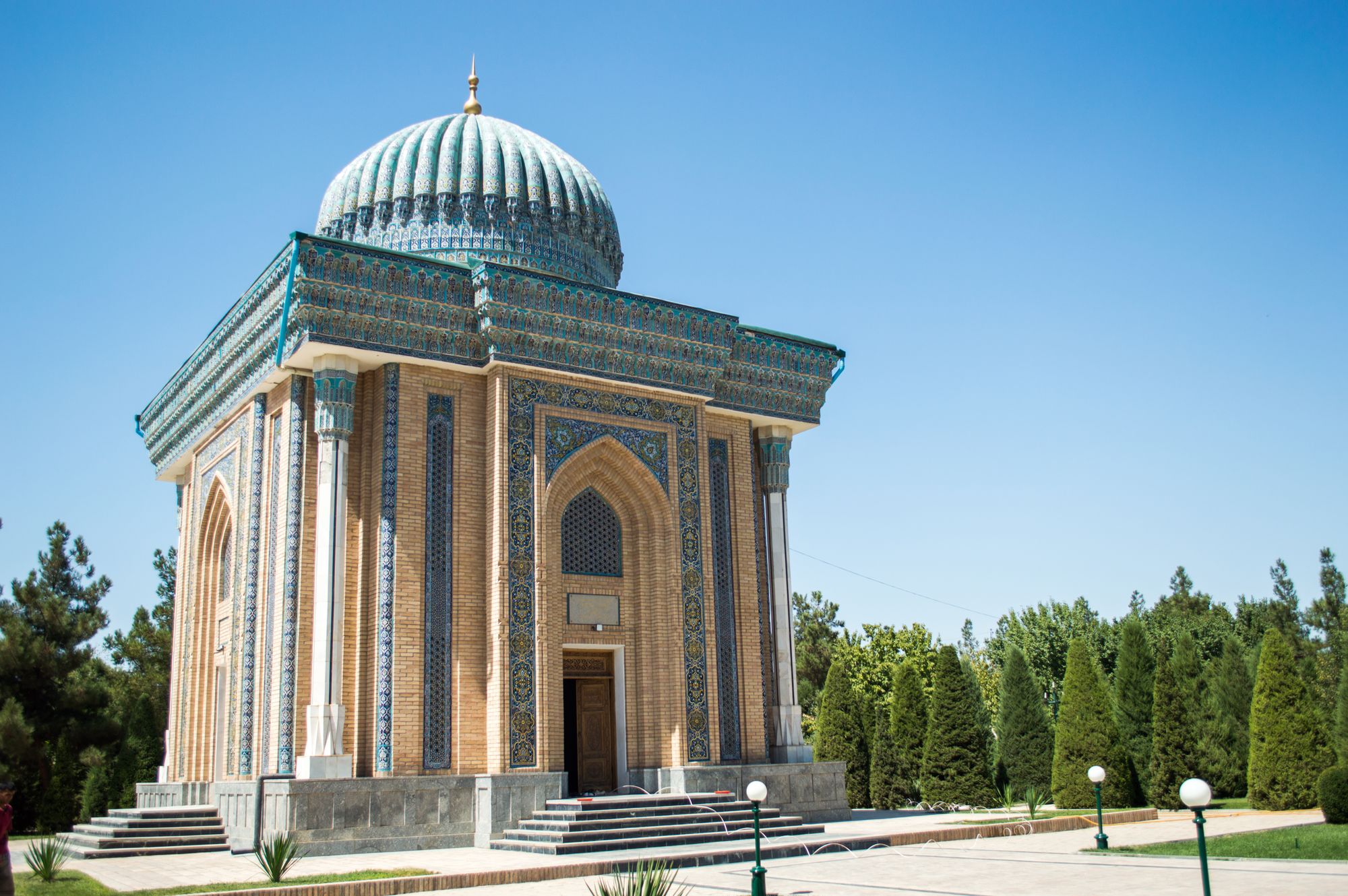
- Bibi-Khanym Mosque - Erected in 1399-1404 by Timur, the founder of the Timurid Empire, the mosque was named after his wife, Saray Mulk Khanum, who was commonly referred to as Bibi-Khanym.
- Registan Square - Located in the heart of the ancient city is one of the most iconic and historically significant squares in Central Asia and a popular tourist attraction. It serves as a prime example of Islamic architecture and a testament to the grandeur of the Timurid dynasty. The word "Registan" translates to "sandy place" or "desert" in Persian, reflecting the square's origins as a marketplace and public gathering space. The Registan Square is surrounded by three magnificent madrasas (Islamic schools): Ulugh Beg Madrasa (completed in 1420), Sher-Dor Madrasa (completed in 1636) and Tilya-Kori Madrasa (completed in 1660), that are known for their intricate tilework, towering facades, and elaborate arches.
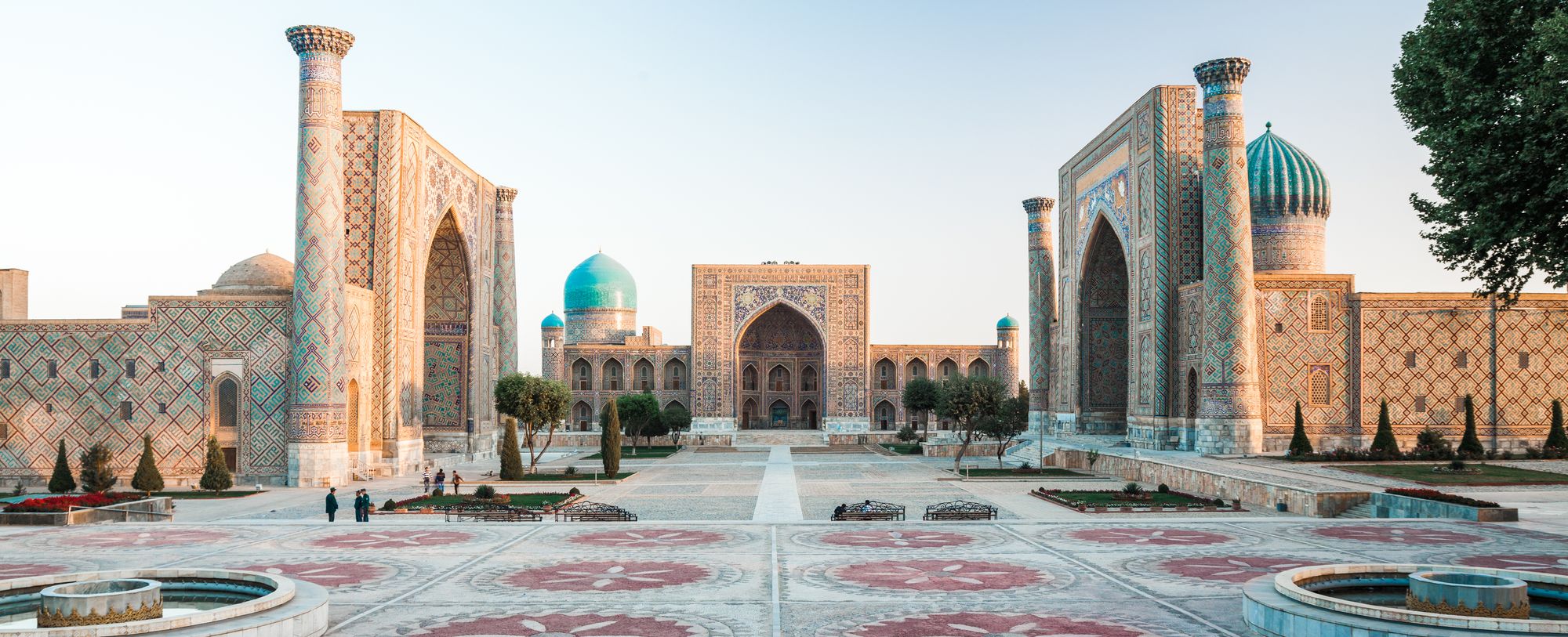
- Shakhi-Zinda complex - Translates to "Living King" in Persian and is believed to hold the tomb of Qutham ibn Abbas, a cousin of Muhammad (pbuh). He came to Samarkand in the 7th century and was amongst the first people to preach Islam in the area. The complex is also treasured for its architectural design, with the ensemble including mausoleums and other buildings from the 11th to 19th centuries.
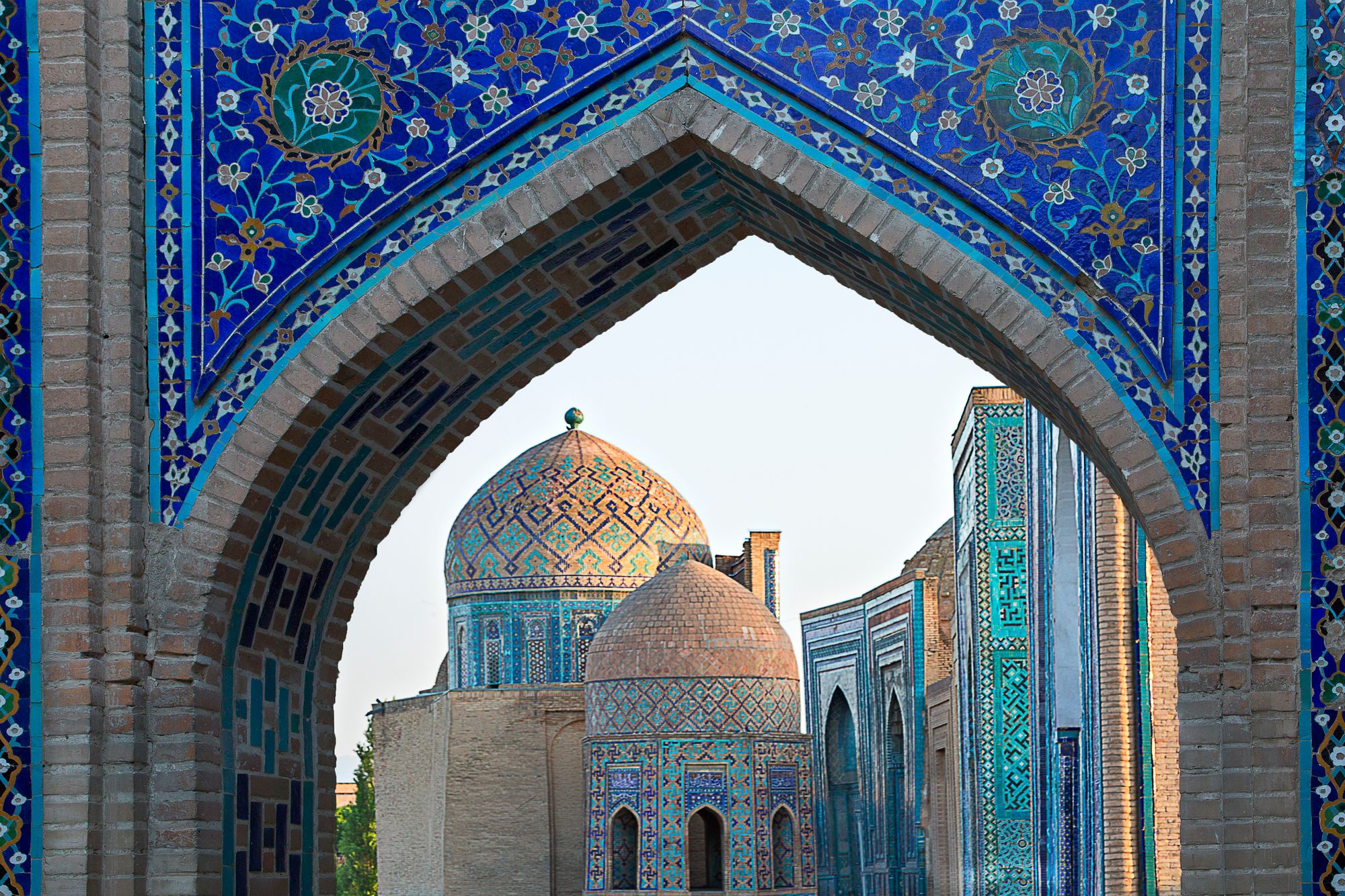
- Ancient Settlement Afrasiab - One of Central Asia's most important archaeological sites. This ancient settlement dates back to the 8th century BC.
- Gur-e Amir Mausoleum - Translates to "Tomb of the King" or "King's Grave" in Persian and is the final resting place of Timur. It is a significant architectural masterpiece and an important cultural site in Central Asia. The structure features a distinctive blue dome and intricate tilework, showcasing the architectural style of the Timurid dynasty. The cenotaph of Timur is at the centre of the building, surrounded by those of his sons and grandsons, including Ulugh Beg.
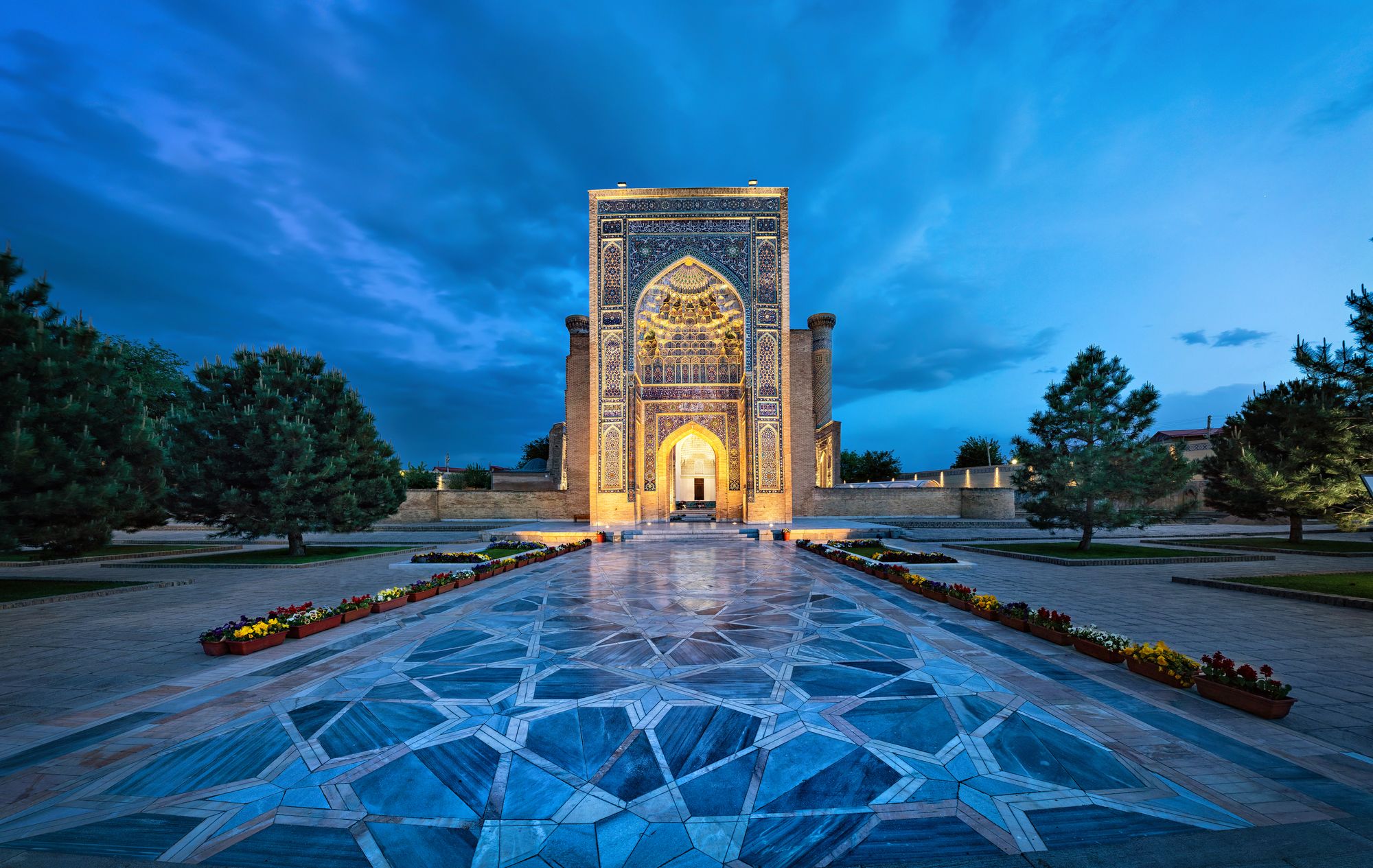
- Ruins of Ulugh Beg’s Observatory - It was constructed between 1424 and 1429 under the patronage of Ulugh Beg, a Timurid ruler and grandson of Amir Timur who was also a notable astronomer and mathematician. Ulugh Beg’s scientific equipment was accurate enough to measure the length of a year (the time it takes for Earth to complete one orbit around the Sun) to within seconds of the modern value. Today, the original site of the Ulugh Beg Observatory is a museum and historical monument.
Khiva & Itchan Kala
A significant tourist attraction in Uzbekistan, Khiva is affectionately known as ”the museum under the sky” due to its incredibly well-preserved historical architecture and landmarks.
Dating back more than 2,500 years, the ancient city is one of the oldest in Central Asia. The “father of algebra” and the decimal point, Abdullah Muhammad Ibn Musa Al-Khwarizmi, a Persian polymath, was born in the city of Khwarizm, now Khiva around the late 8th century or early 9th century. His book “Kitab al-Jabr w'al-Muqabala” (“The Compendious Book on Calculation by Completion and Balancing”) laid out systematic methods for solving linear and quadratic equations. The word “algebra” itself is derived from the Arabic title of his book, “al-Jabr”.
The ancient inner town (Itchan Kala), a UNESCO World Heritage Site, is known for being surrounded by a centuries-old brick wall, some 10-metres high. It used to be the final resting spot for caravans before crossing the desert for Iran.
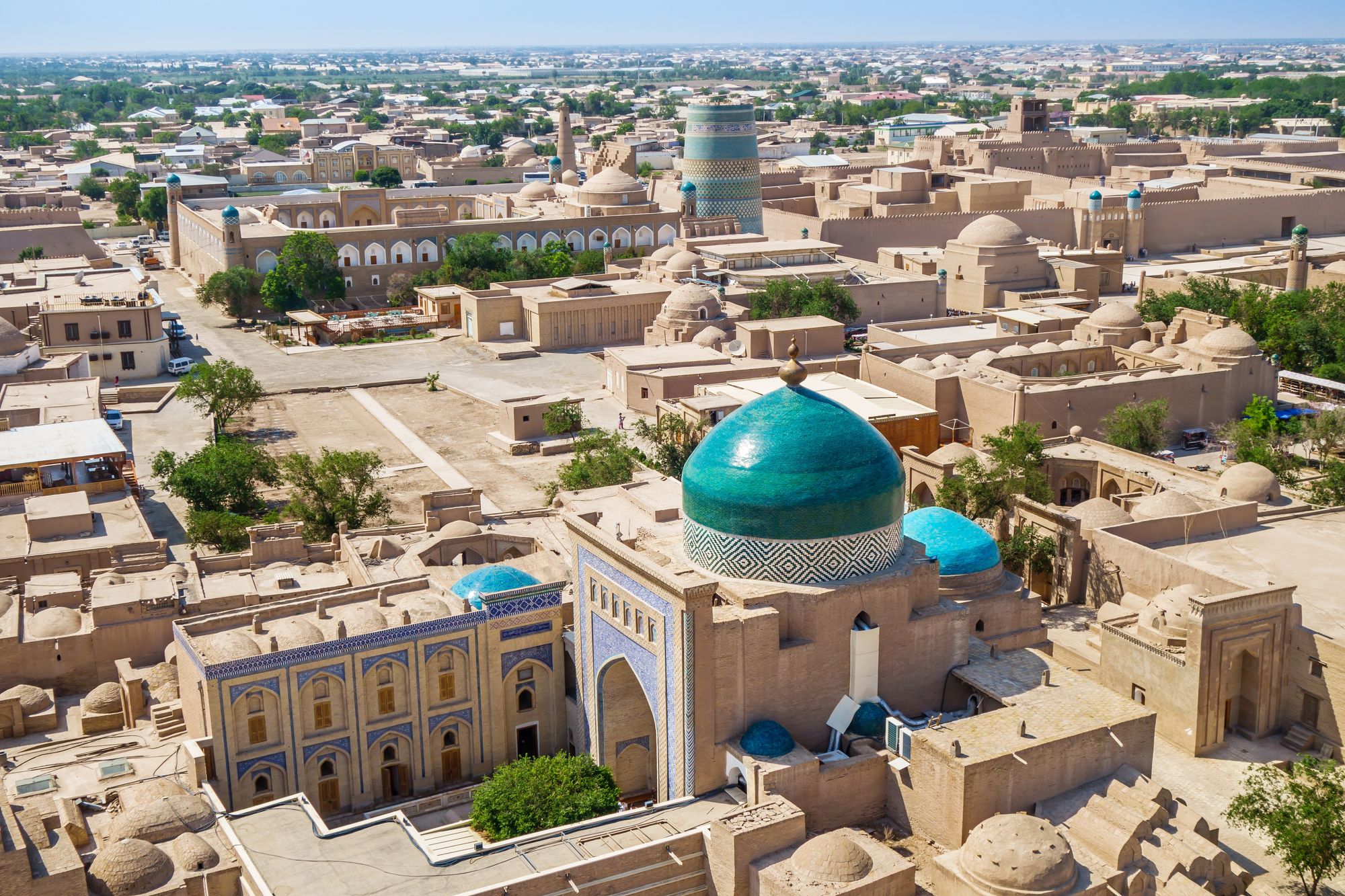
Within Itchan Kala, you'll find a plethora of well-preserved architectural wonders, including palaces, mosques, madrasas, mausoleums, minarets, and other structures. It has over 50 historic monuments and 250 houses that go back to the 18th or 19th centuries. Notable structures in the old town include Juma Mosque, built in the tenth century, and the striking unfinished turquoise-tiled Kalta Minor Minaret.
Several mausoleums and madrasas, including grand palaces like Tosh Hovli and Nurullabay Palace, also exist.
Historic Centre of Shakhrisabz
Located along the Silk Roads in southern Uzbekistan, the Historic Centre of Shakhrisabz is over 2000 years old and a UNESCO World Heritage Site. The site served as the cultural and political hub of the Kesh region during the 14th and 15th centuries. It is characterised by its impressive architectural landmarks, including palaces, mosques, mausoleums, and other structures. These buildings showcase a blend of Islamic, Persian, and Central Asian architectural styles.
Its exceptional monuments and ancient quarters testify to the city's influence under the rule of Timur. The city is renowned for being the birthplace of the country’s national hero, Amir Timur.
Built in 1380, the Ak-Saray Palace, meaning “White Palace”, is a ruined palace and historic site, which still has the foundations of its impressively big gate — once considered the largest in central Asia.
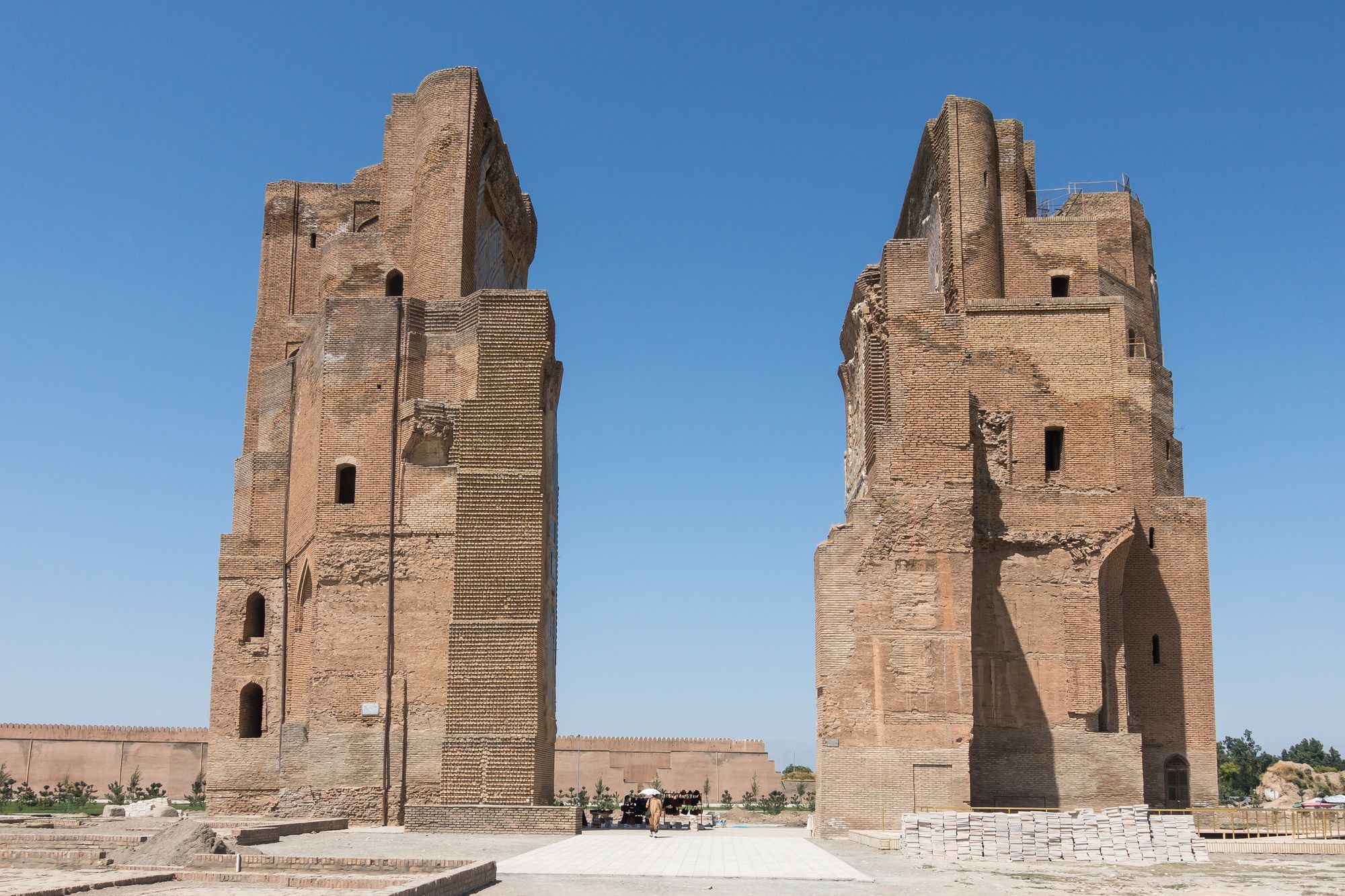
The Dorus Saodat complex (“Gate of Nobility”) was a resting place for the ruling family and includes the tomb of Timur’s sons Jahongir and Omar.
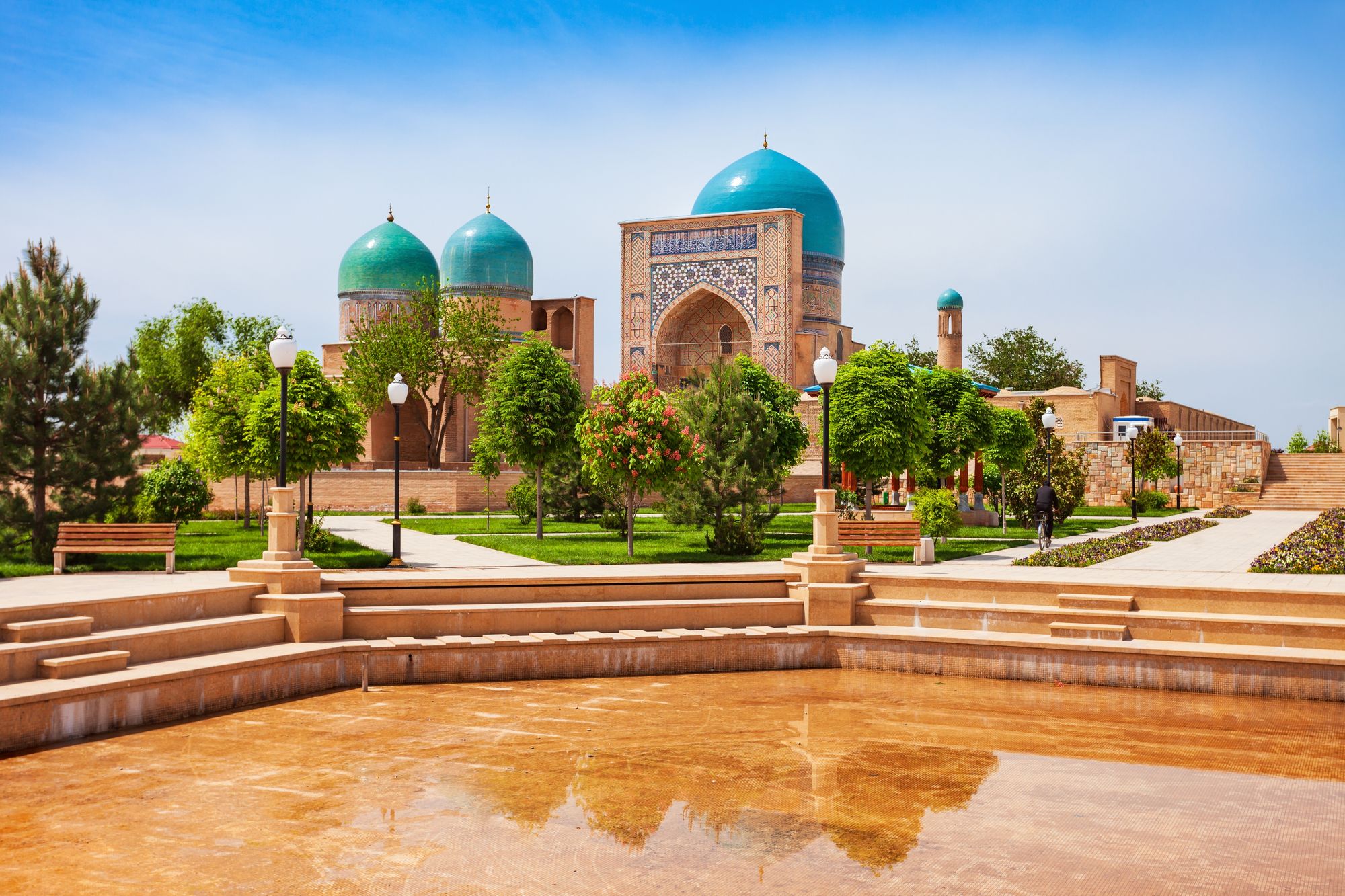
It's also a great place for those who prefer the outdoors. The city offers hiking and biking enthusiasts the Zeravshan Mountains, while the Kyzylkum Desert is a favoured spot for camping and exploring wildlife.
Western Tien-Shan
The Tien-Shan mountain system is one of the largest mountain ranges in the world, varying in altitude from 700 to 4,503 m and ranging from Uzbekistan and Kazakhstan over Kyrgyzstan to East Turkestan (China’s Xinjiang province).
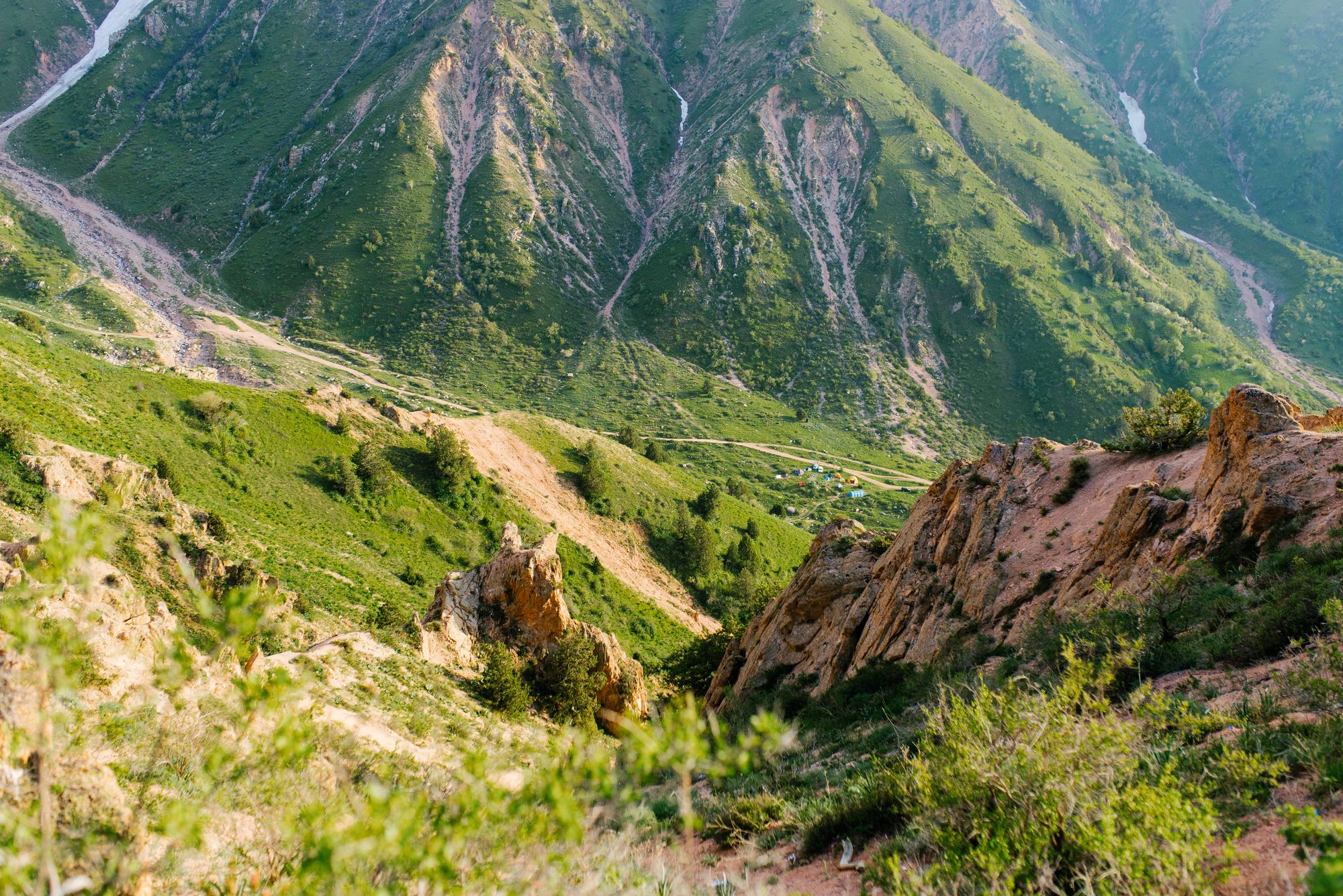
With its varied landscapes, Western Tien-Shan is home to a rich biodiversity. It holds global significance for several cultivated fruit crops and has around 1300 unique plants and is listed as a UNESCO World Heritage Site.
Animals specific to the region include the endangered Snow Leopard, the Eastern Imperial Eagle, Siberian Mountain goats and Himalayan Brown Bear.
There is also evidence of human history in the ancient petroglyphs found on the mountains and rocks. Despite the challenging terrain and harsh conditions, many people brave the elements to get a glimpse of the scenic mountain ranges and everything it holds.
Tashkent
The capital of Uzbekistan and the largest city in Central Asia, Tashkent is the business and culture centre of the country.
It's a city of wide avenues and green alleys, with architecture from different periods, including Soviet architecture, modern architecture, and the centuries-old minarets and mosques. It has cuisine from around the world, but most importantly, Uzbek cuisine.
- Khazrati Imam/Hast Imam complex - A major attraction in the city, the complex named after Tashkent’s first imam, consists of the Tillya Sheikh mosque, Abu Bakr Kaffal Shashi Mausoleum, Barak Khan Madrasah and Imam al-Bukhari Islamic Institute. The library is said to hold one of the oldest Qurans in the world, the Samarkand Kufic Quran (Koran), written in present-day Iraq and dating back to the eighth century.
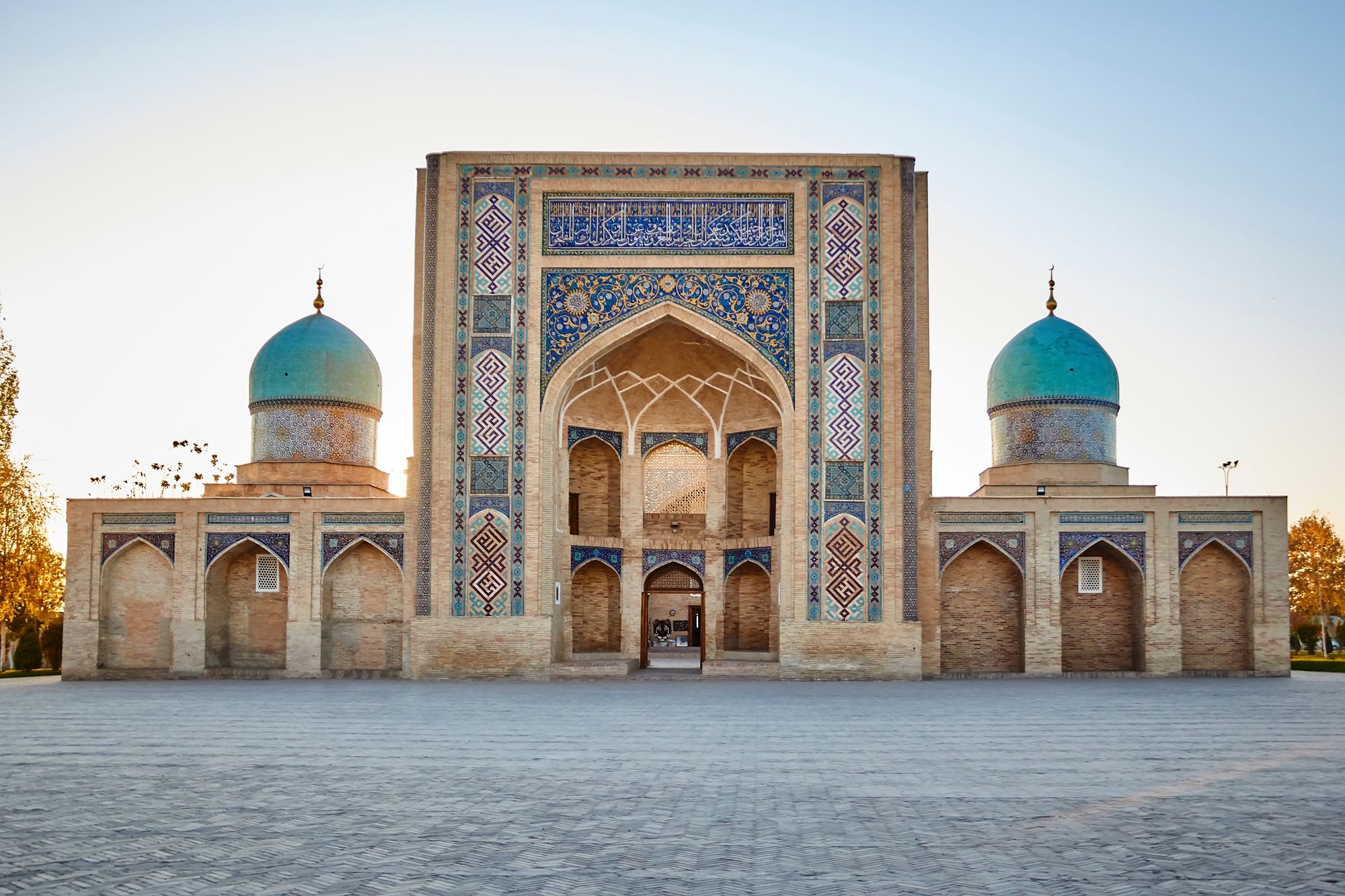
- Tashkent TV tower - You'll see this 375-metre-high tower from anywhere in the city. When it was completed in 1985, it was the fourth tallest tower in the world. Its distinctive lattice structure was specifically created to withstand earthquakes.
- State Museum of the Timurids History - Opened in 1996 in honour of the great commander Amir Timur, the Museum exhibits the history of Uzbekistan during the Timurid dynasty.
- Chorsu Bazaar - A traditional marketplace in the centre of the Old Town, it's a great place to immerse yourself in the local culture. Traders, merchants and travellers have congregated here for hundreds of years to buy and sell daily goods and to trade stories and experiences.
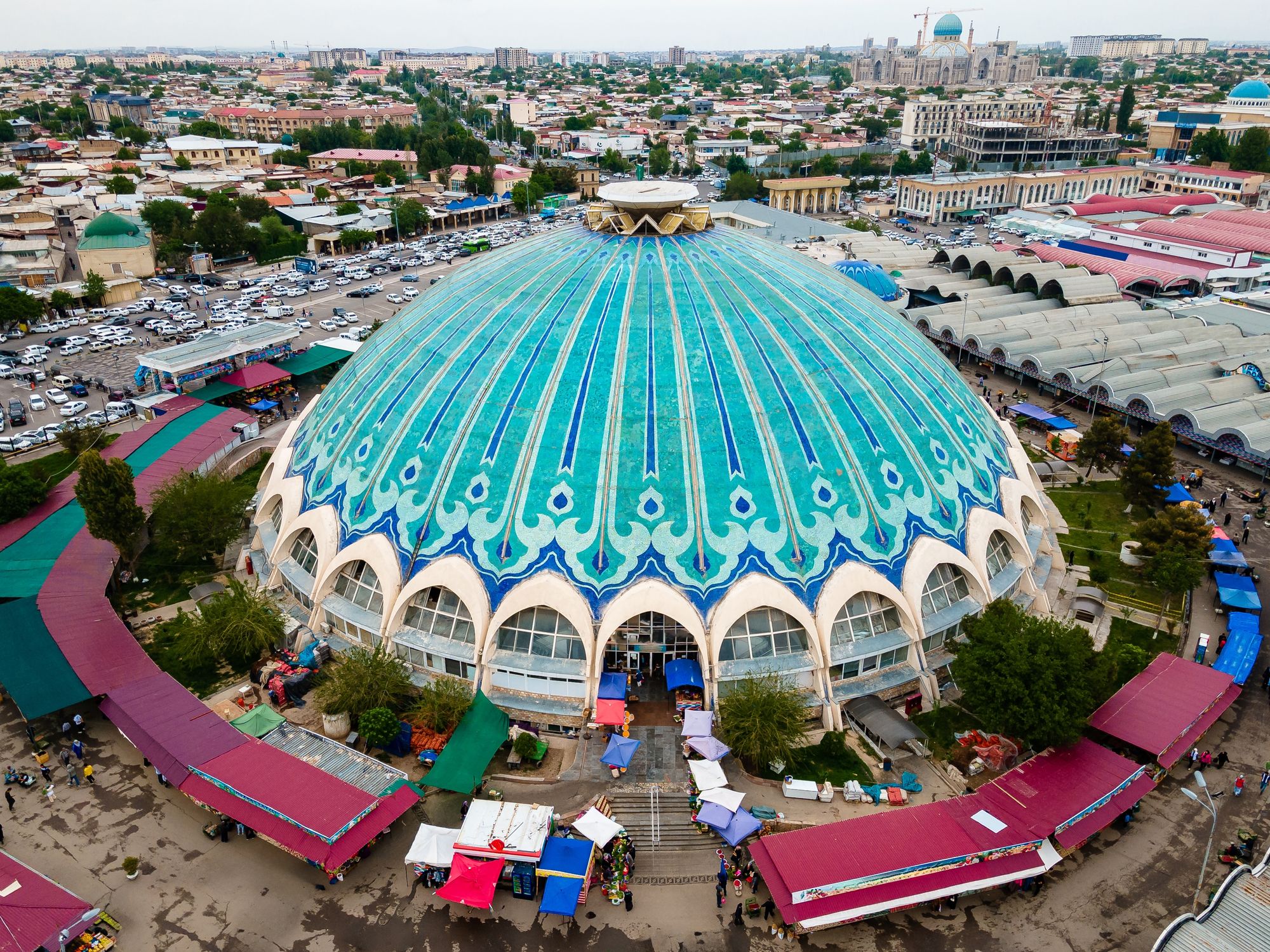
Mosques in Uzbekistan
Uzbekistan has many historical mosques, minarets, and madrasas that showcase its Islamic legacy. Several mosques have already been described, but there are many more, worthy of a mention:
Baland Mosque, Bukhara
A 16th-century mosque that features two prayer spaces. One's designed for the warmth of summer, adorned with intricate wooden muqarnas. The other caters for the winter months and boasts captivating mosaics.
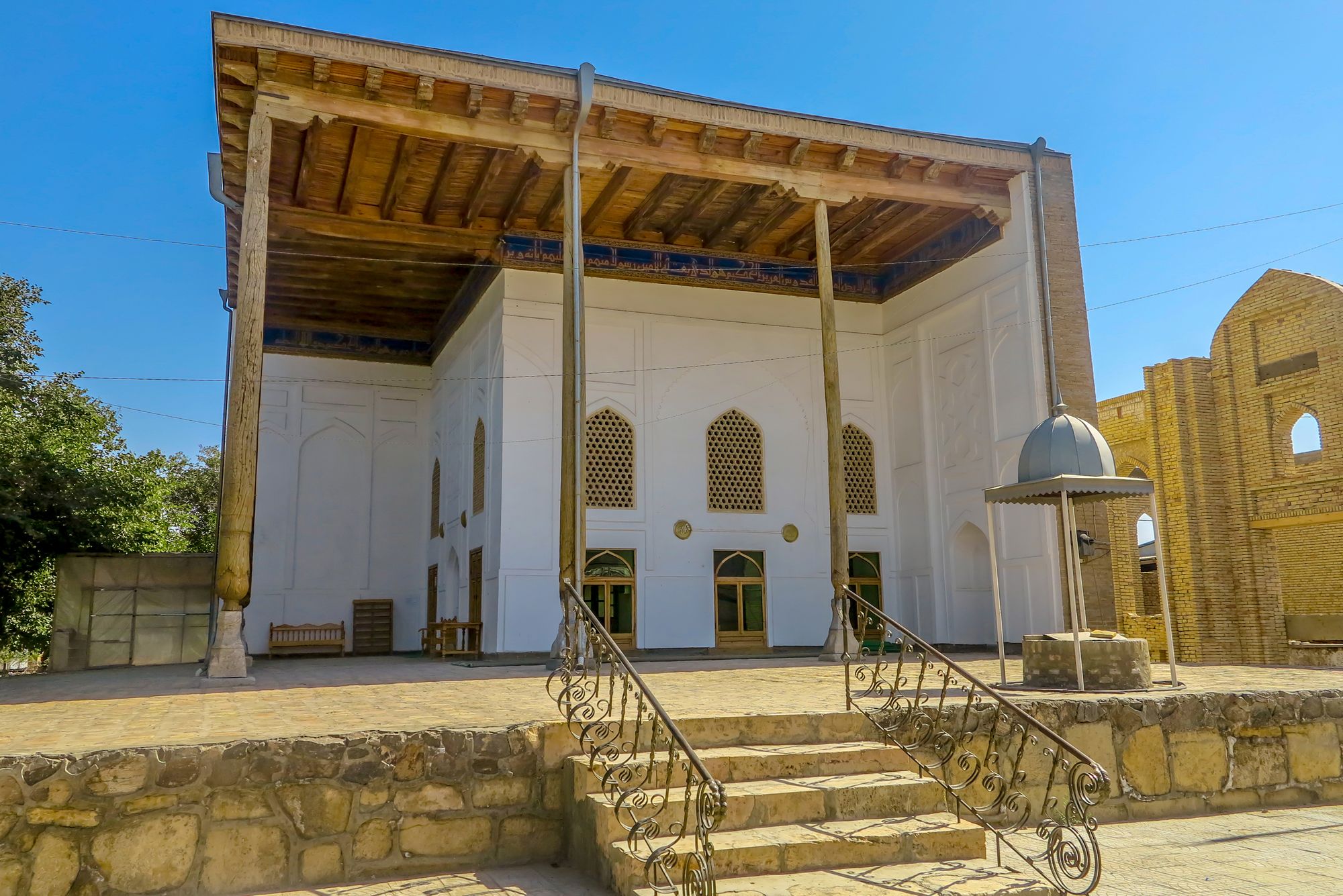
Tilla Kori Mosque, Samarkand
Housed within Tilla Kori Madrasah, which dates back to the 17th century, the mosque's lavish interior is adorned in gold leaf. Tilla Kori translates as "decorated with gold."
Kok Gumbaz Mosque, Shakhrisabz
The central mosque of Shahrisabz was built close to Timur's summer palace and finalised in 1436. It features a spacious central courtyard surrounded by a colonnade of pointed arches, adorned with intricate blue tilework.
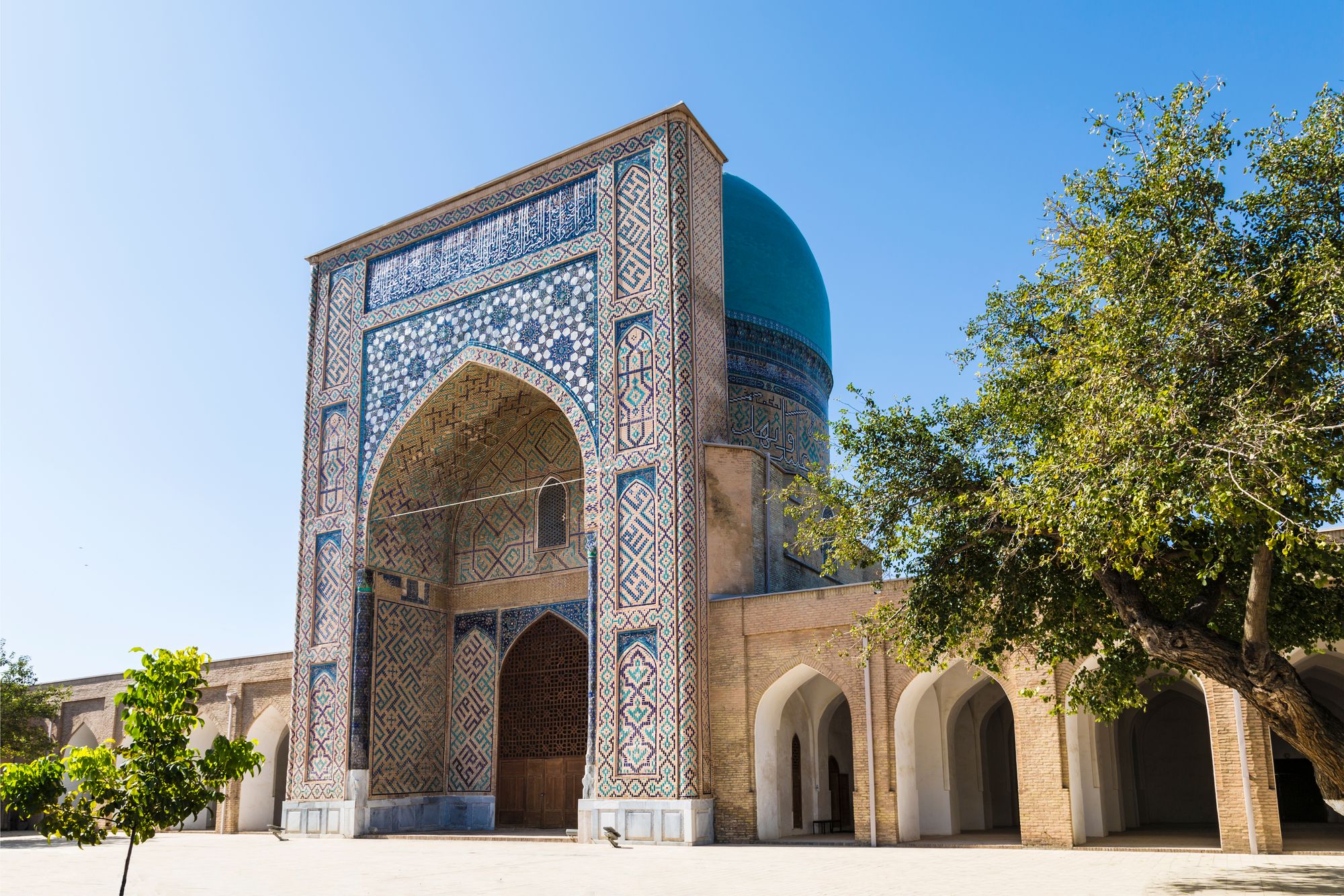
Chor Minor, Bukhara
A distinctive mosque built in 1807, its striking architecture includes four ceramic domed towers, each decorated with motifs representing different world religions.
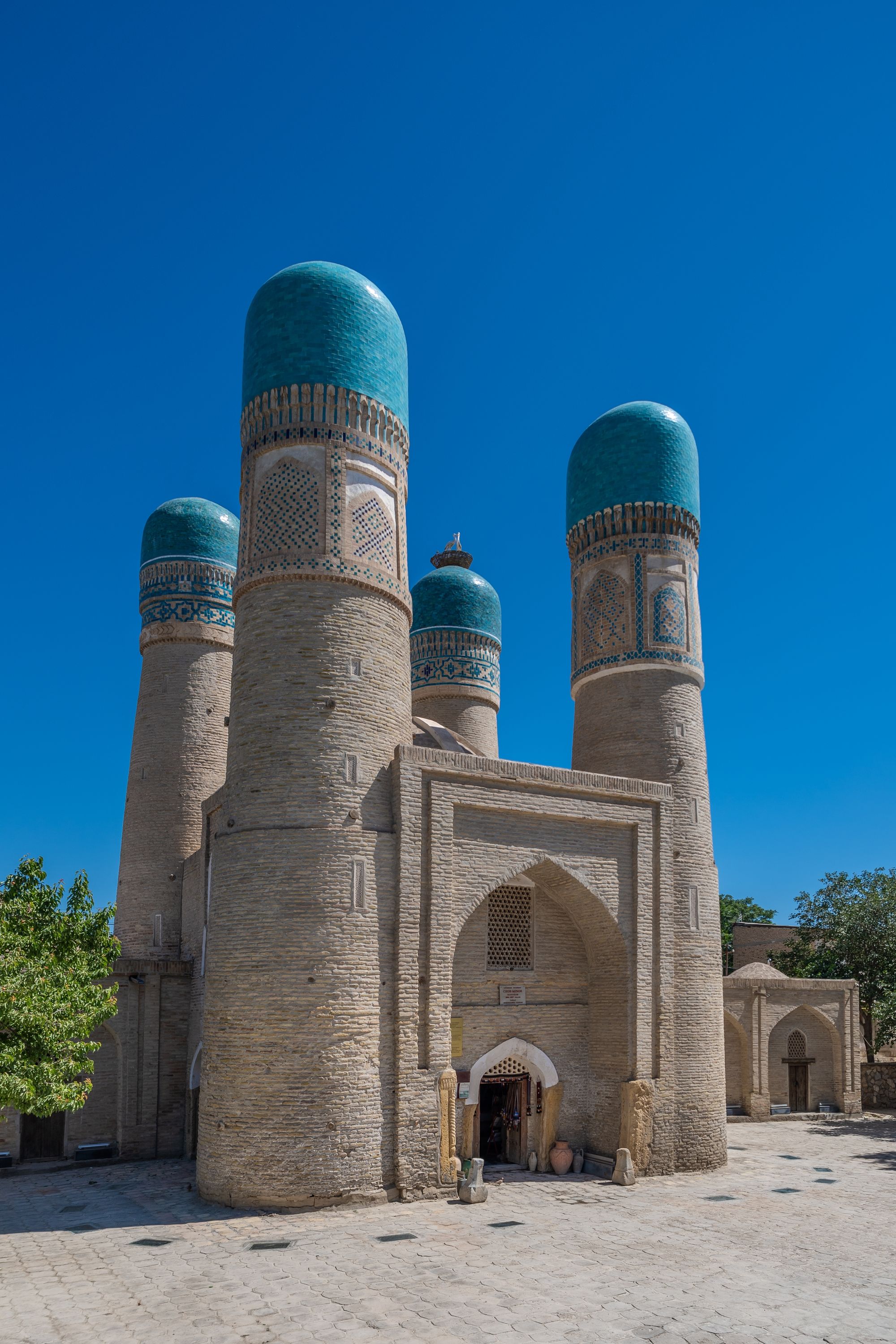
Minor Mosque, Tashkent
Built in 2014, this relatively new mosque is made of white marble. It’s created in traditional oriental and Uzbek architectural styles. Designed to hold more than 2,400 people, it's one of the largest Muslim centres in Uzbekistan.
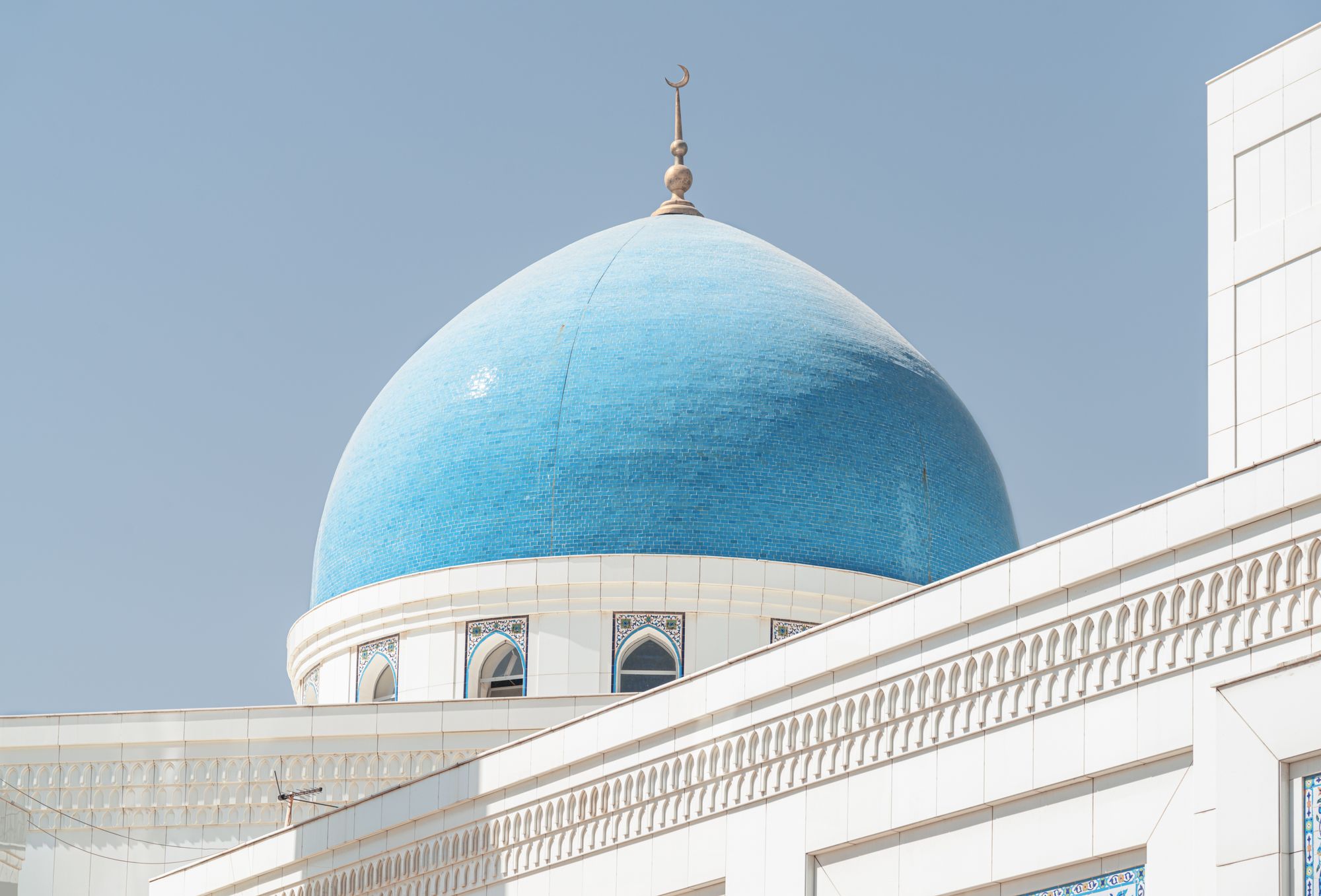
Halal food and restaurants in Uzbekistan
Uzbekistan is a Muslim country, so all the food served in restaurants is halal. Uzbek cuisine incorporates centuries-old culinary traditions from both settled and nomadic communities in the region.
Given its historical position as a trade hub, it's easy to see how the local cuisine has absorbed influences from cultures around the world.
Uzbek cooking has mastered the art of slow cooking, and it's generous when it comes to using spices, thanks to the influence of Persia, India, and China.
The food is also rich in local ingredients like pomegranates, apricots, and melons, while the flatbreads are legendary.
- Plov/Pilaf - Widely considered the national dish, it features tender rice, succulent meat, spices such as cumin, caramelised onions and raisins and chickpeas in a heavy pot that's gently cooked.
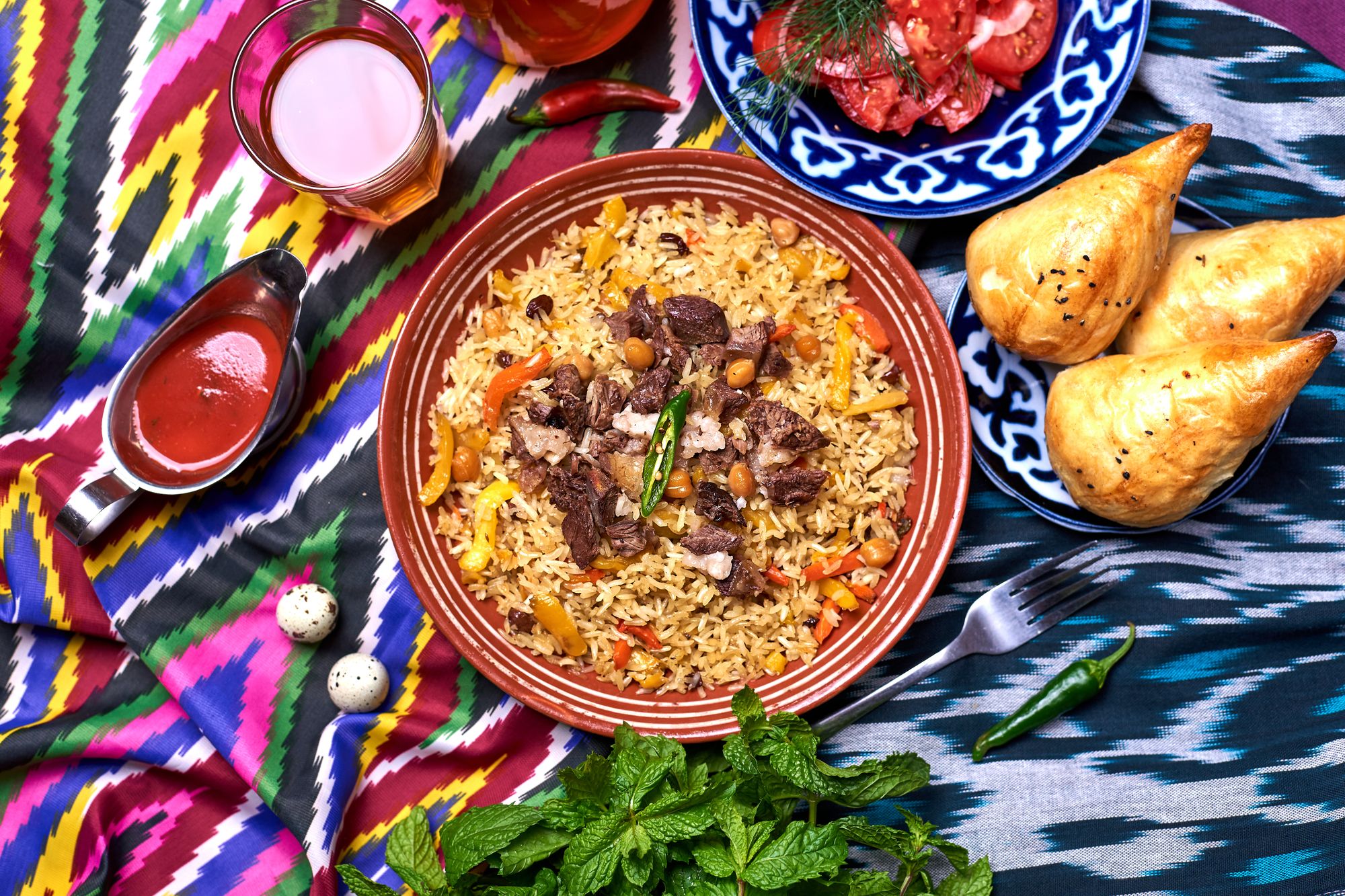
- Manti - Steamed dumplings filled with minced meat and onions. They are typically larger than dumplings from other cuisines and are served with a side of yoghurt or sour cream.
- Kazan patyr - A hot flatbread with a tender crumb and crispy crust, usually eaten for breakfast.
- Samsa - Savoury pastries filled with meat or vegetables with a golden crispy crust.
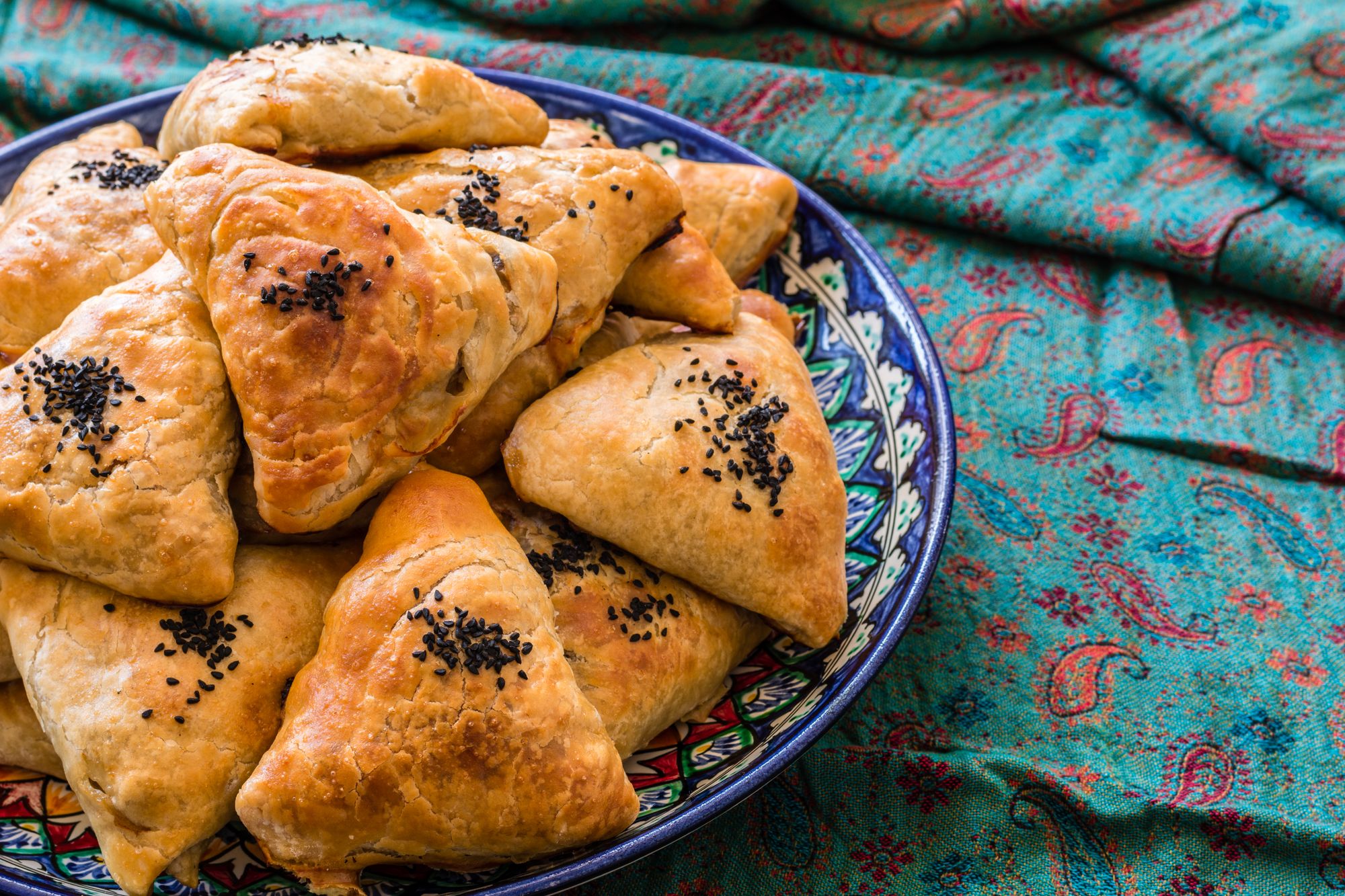
- Kazan kabob - Stewed meat with potatoes and onions in a cauldron.
- Shivit osh - Uzbek pasta on dill infusion, it’s a national dish of Khiva.
- Bedana kabob - Fragrant stuffed quail and lamb, spices and vegetables. It's a delicacy that used to be served to wealthy Uzbek families.
- Shurpa - A hearty soup made with chunks of meat, vegetables, and herbs.
- Shashlik - Consists of skewered and grilled pieces of marinated meat, commonly lamb, beef, or chicken. It's often served with bread, onions, and fresh herbs. Shish kebab is called shashlik. In countries outside Central Asia it is more often known as “shish kebab”. In Uzbekistan “kebab” is usually associated with “cauldron kabob” or “kazan-kabob” which are not barbecue dishes.
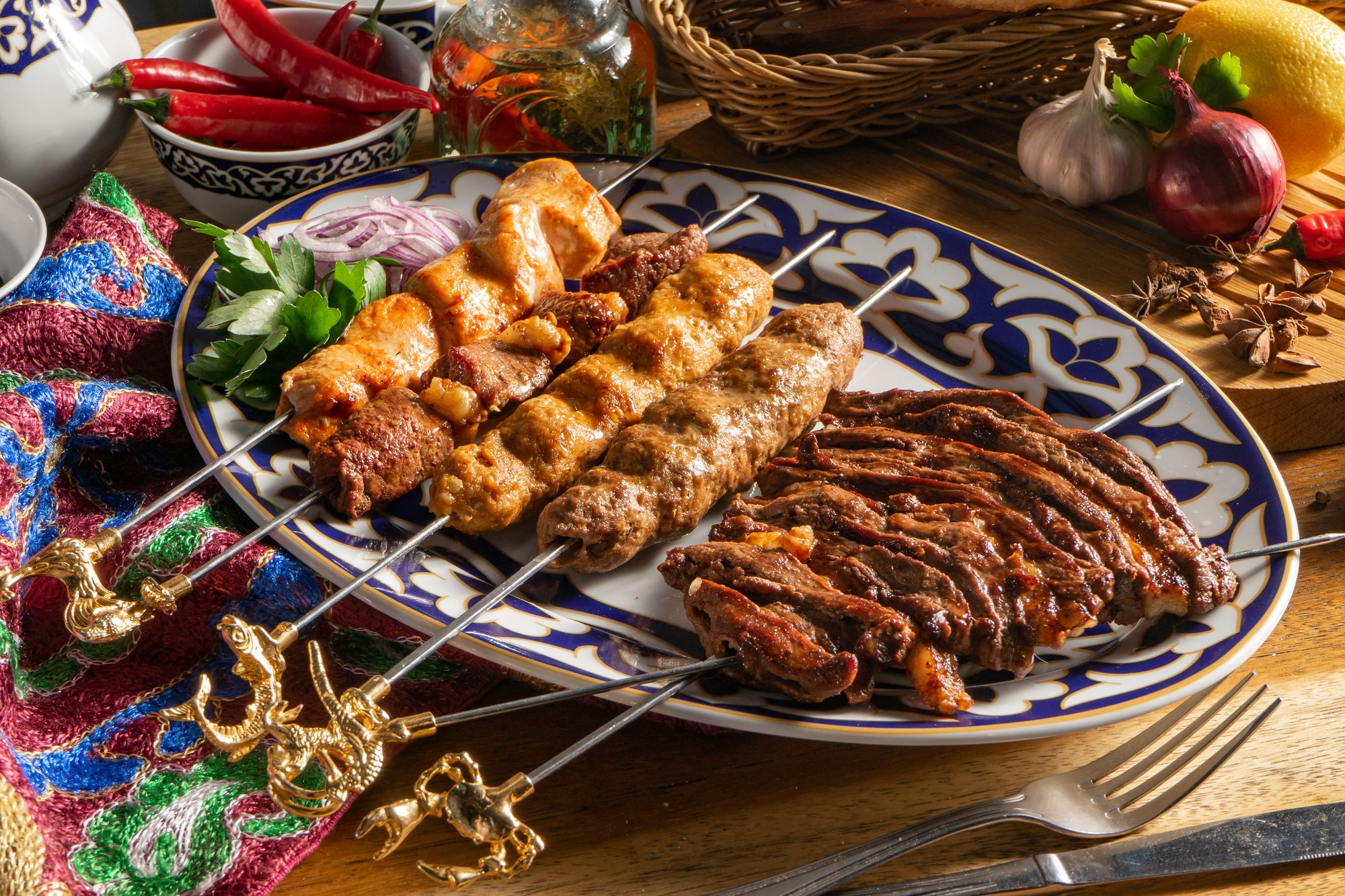
How to get around Uzbekistan
Tashkent has a metro service that consists of four lines that serve nearly 50 stations. It’s worth using it in order to see the impressive and unique stations typical for metro stations from the Soviet era.
The train network in Uzbekistan is well-developed, connecting major cities, and it offers an easy and comfortable way to move around. The high-speed Afrosiyob train goes through several cities, including Tashkent, Samarkand, and Bukhara:
- Tashkent – Bukhara (4 hrs)
- Tashkent – Samarkand (2 hrs)
- Samarkand – Bukhara (1.5 hrs)
Slower trains take one-and-a-half or two times longer.
If you want to hit the road, a shared taxi or minibus is a fast and cheap alternative. Ride-hailing and taxi apps are available. If you fancy more freedom, renting a car and driving through the country is an option. The major roads are in decent condition, although some roads may be bumpy.
Long-distance buses are slow and uncomfortable — and not much cheaper than a second-class train ticket. Though city buses are a more affordable way to move around.
Flying is a time-saver, especially if you cover long distances between cities. International flights arrive in Tashkent and Samarkand. There are also domestic flights between those cities and others like Bukhara and Urgench, the main gateway for tourists to Khiva.
Best time to visit Uzbekistan
The best times to visit Uzbekistan are around spring (April/May) and autumn (September to early November) which is also the peak season. It's also when major events occur. The weather is mild in spring, while autumn offers cooler temperatures and clearer skies - perfect for outdoor exploration. In the summer months, temperatures can reach a sweaty 40+ degrees.
Winter is good for people who don't like crowds. The weather can be unpredictable, though: sunny weather can change quickly to stormy and rainy several times a week.
Where to stay in Uzbekistan
Halalbooking features over 400 hotels throughout Uzbekistan. All of them serve halal food and many are completely alcohol-free. Some have women-only pools or spas. Use the halal filters to find accommodation which suits your requirements.
Central Palace Halal Hotel, Tashkent
A centrally-located alcohol-free hotel with fully-secluded indoor pool and spa available for private hire. Highly rated for its friendly staff, it is a great base for exploring within an easy walk of all sights.
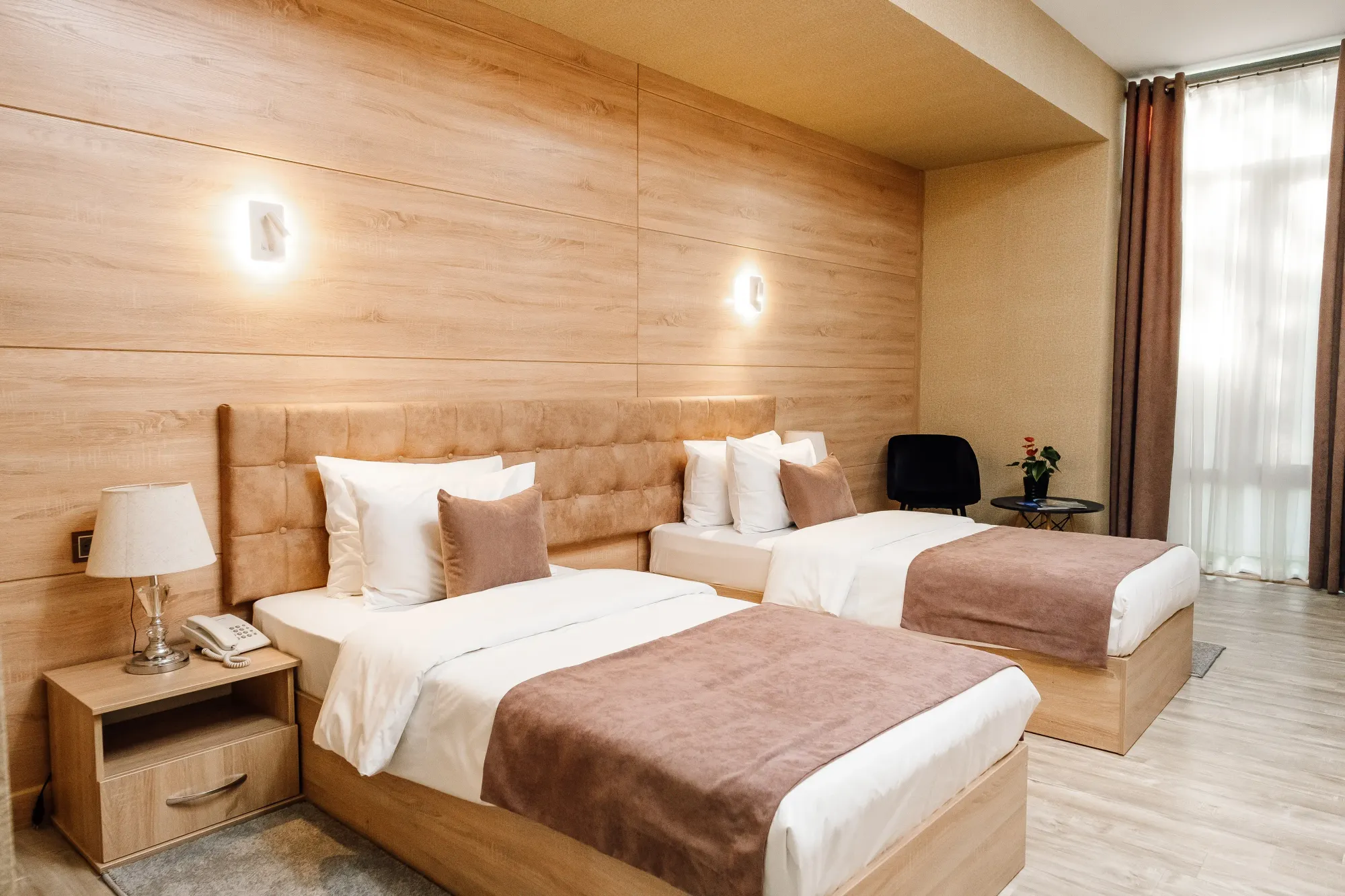
Arkanchi Hotel, Khiva ⭐⭐⭐
An alcohol-free hotel within an easy walk of all main sights, with fully-secluded sauna available for private hire. It is centrally located close to the Alla Kuki Khan Madrasa, Stone Palace and Djuma Mosque.
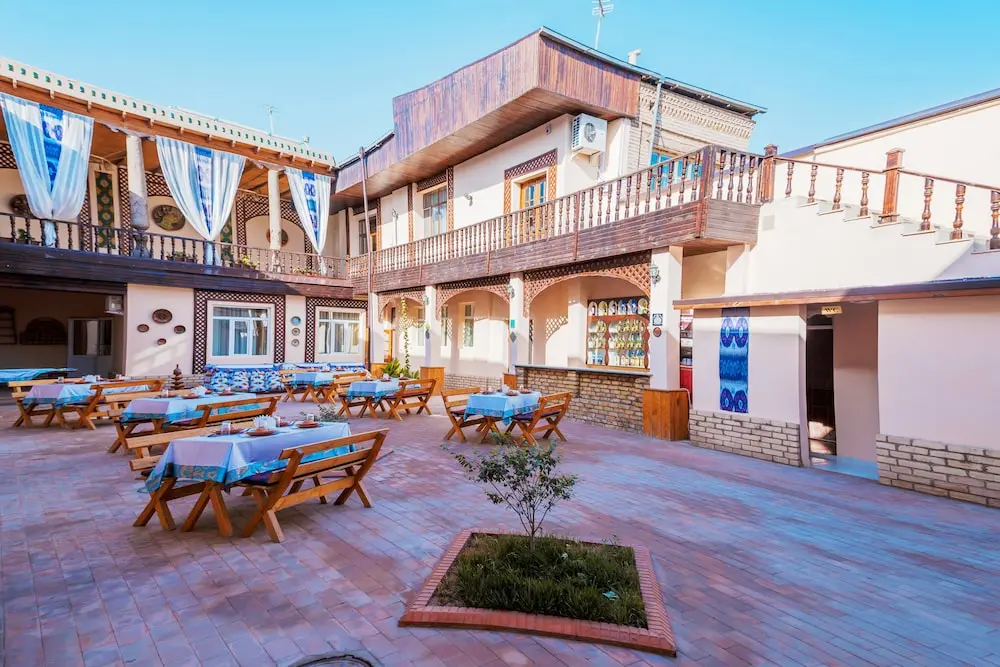
Suggested 7 day itinerary for your trip to Uzbekistan
- Day 1: Arrival in Tashkent - Settle into your hotel accommodation. Stroll across Amir Timur Square and admire the statue of the great military leader. Explore the Hazrati Imam/Hast Imam Complex, where you will find the Tillya-Sheikh Mosque. Enjoy a traditional Uzbek dinner in a local restaurant.
- Day 2: Tashkent Cultural Exploration - Visit the State Museum of the History of the Timurids to learn more about the Timurid dynasty. Explore the lively Chorsu Bazaar and immerse yourself in local culture. Optional evening visit to the Tashkent TV Tower for panoramic views of the city.
- Day 3: Historical Bukhara - Take a morning flight to Bukhara. Visit the ancient Ark Citadel, once home to rulers and scholars. Explore the Poi-Kalyan Complex and see the stunning minaret and mosque. Take a walk around Lyab-i Hauz and the surrounding madrasas.
- Day 4: Enchanting Samarkand - Travel to the "Pearl of the East". Visit Registan Square and its majestic madrasas. Explore the architectural marvel of the Bibi-Khanym Mosque. Discover the Shah-i-Zinda Complex and its historic mausoleums. Enjoy an evening stroll in Samarkand.
- Day 5: Samarkand's Cultural Gems - Visit the Imam al-Bukhari Complex and learn more about the scholar. Explore the ancient settlement of Afrasiab and uncover its archaeological treasures. Optionally, you can visit the Ulugh Beg Observatory for an insight into historical astronomy. Take an overnight train to Khiva.
- Day 6: Khiva's Ancient Wonders - Explore the ancient city centre of Itchan Kala with its historical monuments. Visit the Kalta-Minor Minaret and the Juma Mosque. Learn more about Islamic history at the Khorezm Mamun Academy. Enjoy a sunset walk along the city walls.
- Day 7: Departure from Tashkent - Fly back to Tashkent from Urgench. Spend your final day shopping for souvenirs and local handicrafts. Visit the Minor Mosque, a masterpiece of modern Islamic architecture. End your visit with another traditional Uzbek dinner at a restaurant.
